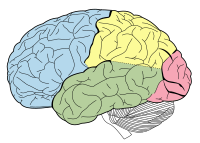
Photo from wikipedia
Effective treatments for chronic pain remain limited. Conceptually, a closed-loop neural interface combining sensory signal detection with therapeutic delivery could produce timely and effective pain relief. Such systems are challenging… Click to show full abstract
Effective treatments for chronic pain remain limited. Conceptually, a closed-loop neural interface combining sensory signal detection with therapeutic delivery could produce timely and effective pain relief. Such systems are challenging to develop because of difficulties in accurate pain detection and ultrafast analgesic delivery. Pain has sensory and affective components, encoded in large part by neural activities in the primary somatosensory cortex (S1) and anterior cingulate cortex (ACC), respectively. Meanwhile, studies show that stimulation of the prefrontal cortex (PFC) produces descending pain control. Here, we designed and tested a brain-machine interface (BMI) combining an automated pain detection arm, based on simultaneously recorded local field potential (LFP) signals from the S1 and ACC, with a treatment arm, based on optogenetic activation or electrical deep brain stimulation (DBS) of the PFC in freely behaving rats. Our multiregion neural interface accurately detected and treated acute evoked pain and chronic pain. This neural interface is activated rapidly, and its efficacy remained stable over time. Given the clinical feasibility of LFP recordings and DBS, our findings suggest that BMI is a promising approach for pain treatment. Description A multiregion brain-machine interface automatically detects pain and delivers ultrafast analgesia for acute and chronic pain in rodents. Pain relief on-demand Chronic pain is a debilitating condition for which there are no effective treatments. The primary somatosensory cortex (S1) and the anterior cingulate cortex (ACC) are involved in decoding pain components, and electrical stimulation of the prefrontal cortex (PFC) has been shown to exert analgesic effects. Here, Sun et al. developed a multiregion brain-machine interface (BMI) able to detect pain from electrical signals in S1 and ACC and provide on-demand PFC stimulation. The BMI was able to accurately detect and treat acute and chronic pain in rats; the analgesic effects were stable over time. The results suggest that BMI approaches might be effective for treating chronic pain of different etiologies.
Journal Title: Science Translational Medicine
Year Published: 2022
Link to full text (if available)
Share on Social Media: Sign Up to like & get
recommendations!